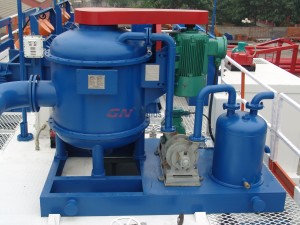Gas Buster is called also called vacuum degasser in oilfield drilling fluids gas separating.

A Gas Buster is a simple separator vessel used to remove free or entrained gas from fluids circulated in the wellbore, such as mud used during drilling operations. The gas buster typically comprises a vessel containing a series of baffles with a liquid exit on the bottom and a gas-vent line at the top of the vessel.
GN oilfield Gas Buster
Our oilfield Gas Buster operates on a “thin strata” principle. The drill mud enters the tank and forces it to flow and distributed to a layer of internal baffle plates engineered to allow the liquid inside the oilfield Gas Buster to flow as thin film and is exposed to the vacuum within the vessel. This layer of mud allows the gas to escape or break out of the mud . The vacuum pump releases the gas and discharge it to the disposal line. Mud exits the vessel under the action of the venturi and is returned to the mud system.
GN Gas Buster operates in three functions – mud circulation, vacuum creation and gas removal. The Gas Buster is used to remove the small entrained gas bubbles left in the mud by the mud/gas separator. These units are positioned downstream from mud/gas separators, gumbo removal equipments (if utilized), shale shakers and mud conditioners (if utilized), while hydrocyclone desander and Decanting centrifuges follow in the arrangement.
Gas Buster type
Vacuum tank degasser Type is the most common form of degasser. Vacuum tank degasser can be horizontal, vertical or round vessel. A vacuum action is created to pull in the gas cut mud. When the liquid enters the tank it will flow and be distributed to a layer of internal baffle plates designed for the mud to flow in thin laminar film and is exposed to a vacuum that forces the gas to escape and break out of the mud.The vacuum pump moves the escaping gas from the vessel discharging it to the rig’s flare or environmental control system. Vacuum degassers are neccessory for drilling mud system in oilfield.